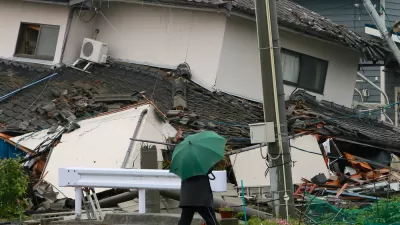Having just returned from a United Nations-led tour of disaster-ravaged areas of Japan, Warren Karlenzig reports on efforts across the region to rebuild along smart growth and green economic development models.
With the one-year anniversary of the Tōhoku earthquake and tsunami and Fukushima Daiichi nuclear accident fast approaching, Karlenzig recently toured six tsunami-damaged communities and two radiation-impacted cities in Northern Japan as part of a UN Center for Regional Development (UNCRD) fact-finding mission, one of the first (if not the first) from outside the three affected prefectures to meet with local leaders on reconstruction and post-disaster management planning.
Although the full rebuilding effort will not begin for several years due to a number of factors (unstable ground, waste removement, etc.), many communities have already submitted reconstruction plans including land use schemes to the national government, and Karlenzig points to the plans of two particular tsunami-ravaged cities that stand out for being smart growth models.
In Ishinomaki,a pre-tsunami city of about 160,000 which had the most tsunami deaths of any city, "has a plan to virtually wipe clean its remaining 'ghost' downtown to create a mixed-use residential-commercial zone that will be 2-3 times as denser than before," writes Karlenzig. He also sees transit-oriented redesign as a strategy being utilized to keep and attract younger citizens.
With the country scrambling to replace the 25-30% of the nation's energy supply that came from now mostly shuttered nuclear facilities, quickly growing the country's renewable energy production will be of importance nationwide, and as the basis for developing the economies of disaster-ravaged areas.
"Rikuzentakada, a city of 22,000 (2,000 died in the tsunami), is making plans to make 'new energy' a key part of its redevelopment vision. This city which was reported to have been "wiped off the map," by 65-foot (19.2 meter) waves is today pursuing national government subsidies and private investments to create large-scale distributed generation of renewables, including PV solar, land biomass (wood), marine biomass and offshore wind."
Later this month, Karlenzig's delegation will work with UNCRD to develop recommendations based on their visit.
FULL STORY: Japan's Green Renewal? After the Disasters UN Tour

Planetizen Federal Action Tracker
A weekly monitor of how Trump’s orders and actions are impacting planners and planning in America.

Maui's Vacation Rental Debate Turns Ugly
Verbal attacks, misinformation campaigns and fistfights plague a high-stakes debate to convert thousands of vacation rentals into long-term housing.

Restaurant Patios Were a Pandemic Win — Why Were They so Hard to Keep?
Social distancing requirements and changes in travel patterns prompted cities to pilot new uses for street and sidewalk space. Then it got complicated.

In California Battle of Housing vs. Environment, Housing Just Won
A new state law significantly limits the power of CEQA, an environmental review law that served as a powerful tool for blocking new development.

Boulder Eliminates Parking Minimums Citywide
Officials estimate the cost of building a single underground parking space at up to $100,000.

Orange County, Florida Adopts Largest US “Sprawl Repair” Code
The ‘Orange Code’ seeks to rectify decades of sprawl-inducing, car-oriented development.
Urban Design for Planners 1: Software Tools
This six-course series explores essential urban design concepts using open source software and equips planners with the tools they need to participate fully in the urban design process.
Planning for Universal Design
Learn the tools for implementing Universal Design in planning regulations.
Heyer Gruel & Associates PA
JM Goldson LLC
Custer County Colorado
City of Camden Redevelopment Agency
City of Astoria
Transportation Research & Education Center (TREC) at Portland State University
Jefferson Parish Government
Camden Redevelopment Agency
City of Claremont




























